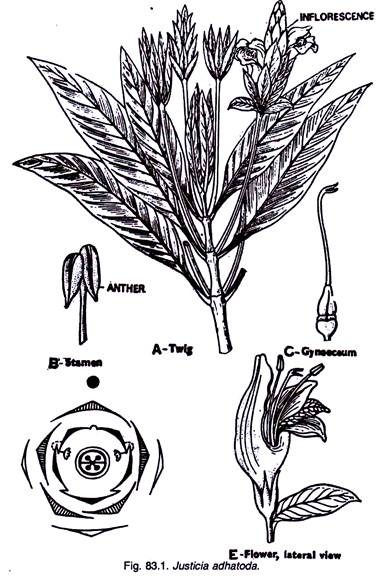ADVERTISEMENTS:
In this article we will discuss about:- 1. Characters of Acanthaceae 2. Distribution of Acanthaceae 3. Economic Importance 4. Affinities 5. Important Types.
Characters of Acanthaceae:
Mostly herbs, shrubs; leaves opposite decussate, exstipulate, inflorescence cymose, flowers bracteate, bracteolate, zygomorphic, hermaphrodite, hypogynous; calyx five or 4 gamosepalous, corolla pentapartite, gamopetalous, often bilipped; stamens 4 to 2 didynamous, polyandrous, epipetalous; carpels two, syncarpous, ovary superior, axile placentation, style simple, stigma bilobed; fruit loculicidal capsule, seeds non-endospermic with jaculators.
A. Vegetative characters:
ADVERTISEMENTS:
Habit:
Plants are mostly herbs, shrubs or a few climbers (Thunbergia)-, some xerophytes (Barleria, Blepharis, Acanthus), aquatic (Asteracantha longifolia).
Root:
Branched tap root system.
ADVERTISEMENTS:
Stem:
Aerial, erect, underground (Ruellia tuberosa), herbaceous or woody, branched cylindrical, node swollen, climbing or twining (Thunbergia), spinous (Barleria).
Leaves:
Opposite decussate, simple, exstipulate, petiolate, usually entire, acute apex, hairy, cystoliths are present in the epidermal cells of stem and leaves.
B. Floral characters:
Inflorescence:
Solitary axillary (Thunbergia), spike (Blepharis) racemes, dichasial or monochasial cymes.
Flower:
Bracteate, bracteolate, bracts and bracteolates conspicuous, pedicellate or sessile, and brightly coloured, hermaphrodite, complete, zygomorphic, pentamerous, or tetramerous, hypogynous, nectariferous disc present below the ovary wall.
ADVERTISEMENTS:
Calyx:
Sepals 4 or 5 gamosepalous, mostly bilabiate, hairy, imbricate, inferior.
Corolla:
Petals 2 to 5, bilipped, gamopetalous, variously coloured, imbricate or twisted, inferior.
ADVERTISEMENTS:
Androecium:
Generally 4, rarely 5 (Penstemon), in some 2 fertile stamens and 2 staminodes, epipetalous, filaments free, dithecous, dorsifixed, alternate with the corolla lobes, one anther lobe may be smaller than the other and unequally placed, anthers sometimes spurred.
Gynoecium:
Bicarpellary, syncarpous, superior, bilocular, axile placentation, carpels median, one or more ovules per loculus, style simple, stigma bilobed, disc present below the ovary.
ADVERTISEMENTS:
Fruit:
Loculicidal capsule or rarely drupe.
Seed:
Non-endospermic with hooks (jaculators).
ADVERTISEMENTS:
Pollination:
Entomophilous.
Floral formula:
Distribution of Acanthaceae:
It is commonly known as Acanthus family. It includes 250 genera and 2500 species. The family is chiefly distributed in tropics and sub-tropics. In India 508 species are present.
Economic Importance of Acanthaceae:
1. Medicinal:
ADVERTISEMENTS:
Many plants of the family are medicinal. Adhatoda vasika and Barleria cristata are used in cough. Roots of Rhinanthus, Ruellia are also used in medicine. Roots of Ecbolium are used in jaundice. Andrographic paniculata is used for liver diseases. Fruits and leaves of Phlogacanthus thyrsiflorus are used for fever. Leaves of Phlogacanthus tubiflorus when rubbed in water yields lather which is used like soap for washing purposes.
2. Ornamental:
Many plants are cultivated for ornamental purposes viz., Acanthus, Barleria, Justicia, Thunbergia, Jacobinia, Ruellia, are often used as hedge.
Primitive characters:
1. A few shrubs.
2. Leaves simple.
ADVERTISEMENTS:
3. Flowers hermaphrodite, hypogynous.
4. Gynoecium superior.
5. Pollination by insects.
Advanced characters:
1. Plants mostly herbs.
2. Leaves exstipulate and opposite.
3. Flowers zygomorphic.
4. Calyx gamosepalous.
5. Corolla gamopetalous.
6. Stamens epipetalous, 2 ferile and 2 staminodes.
7. Gynoecium bicarpellary, syncarpous.
8. Seed non-endospermic.
Affinities of Acanthaceae:
There seems to be agreement among botanist to retain the Acanthaceae as a distinct family. It has been derived from Scrophulariaceae or stocks ancestral to the Scrophulariaceae. Bessey placed it at the top of his Scrophulariales.
But the Acanthaceae differs from the Scrophulariaceae in having bracteate and bracteolate flowers, imbricate sepals of unequal length; loculicidal oaDsule and non-endospermic seeds with jaculators.
It is closely related to the Lamiaceae, but distinguished by a number of characters e.g. absence of aromatic smell, typically quadriangular stem, verticellaster inflorescence, gynobasic style, quadrilocular ovary. These are present in the Lamiaceae.
Common plants of the family:
1. Acanthus ilicifolius:
A mangrove plant with prickly and handsome flowers.
2. Barleria:
Medicinal shrub, bearing two long thorns at each node.
3. Justicia adhatoda (syn. Adhatoda vesica):
Decoction of leaves used in cough syrups.
4. Lepidagathis cuspidata:
A small bushy shrub.
5. Peristrophe bicalyculata:
Branched herb with six-angled stem.
6. Phlogacanthus:
Evergreen shrub.
7. Ruellia:
Ornamental erect herb.
8. Thunbergia:
Climber, producing violet flowers and gives a peculiar smell.
Division of the family and chief genera:
On the basis of seed character the family is divided into 2 sub-families and 5 tribes:
Sub-family 1. Acanthoideae:
Seeds with prominent jaculators and long stalks. It is divided into 2 tribes viz., Contortae, and Imbricatae e.g. Ruellia, Acanthus, Justicea.
Sub-family 2. Thunbergioideae:
Jaculators absent in seeds. It is divided into 3 tribes namely Nelsonieae, Mendoncieae and Thunbergeae e.g. Thunbergia, Mendoncia and Nelsonia.
Important Types of Acanthaceae:
1. Barleria prionitis:
Habit:
A prickly, bushy shrub.
Root:
Tap, branched.
Stem:
Aerial, erect, woody, solid, ridged and furrowed, green, branched.
Leaves:
Simple, opposite decussate, shortly petiolate in the upper region, longer petiolate in lower region, stipulate; stipules intra-petiolar, spinous, elliptical, lanceolate, entire, acute or acuminate, cuneate base, unicostate reticulate.
Inflorescence:
Spike, dichasial cyme in lower region.
Flower:
Bracteate, bracteolate, bracteoles 6, 2 larger 4 smaller, narrow with spiny tip, sessile, complete, hermaphrodite, zygomorphic, pentamerous, hypogynous.
Calyx:
Sepals 4, polysepalous, slightly fused at the base, arranged in 2 whorls of 2 each, two outer bigger, antero-posterior, spine tipped, imbricate, inferior.
Corolla:
Petals 5, gamopetalous, creamy yellow, personate, upper lip with 4 lobes, lower with any 1 petal (4/1) imbricate, inferior.
Androecium:
Two fertile stamens and 2 staminodes, polyandrous, epipetalous, filaments long, anther dorsifixed, dithecous, introrse.
Gynoecium:
Bicarpellary, syncarpous, superior, bilocular, single ovule in each loculus, axile placentation, simple style, cylindrical, stigma simple, bilobed.
Floral formula:
2. Justicia adhatoda (Fig. 83.1) (Syn. Adhatoda vasika):
Habit:
A perennial shrub.
Root:
Tap, branched.
Stem:
Aerial, erect, woody, cylindrical, solid, greenish-yellow, branched, swollen nodes.
Leaves:
Opposite, decussate, simple, petiolate, green, exstipulate, lanceolate, entire, acute, coriacious, unicostate reticulate.
Inflorescence:
Racemose, spike.
Flower:
Bracteate, bracteolate, sessile, complete, hermaphrodite, zygomorphic pentamerous, hypogynous, whitish with pink streaks.
Calyx:
Sepals 5, gamosepalous, green, imbricate, inferior.
Corolla:
Petals 5, gamopetalous, personate (2/3) posterior lip with 2 lobes, imbricate, white with pink streaks, inferior.
Androecium:
Stamens 2, polyandrous, epipetalous, filaments long, hairy at the base, basifixed, dithecous, introrse, anther lobes at unequal height and spurred.
Gynoecium:
Bicarpellary, syncarpous, superior, bilocular, one ovule in each loculus, axile placentation, style long, stigma bifid.
Floral formula:

